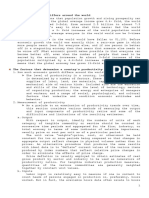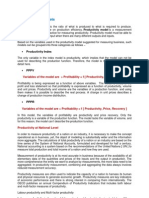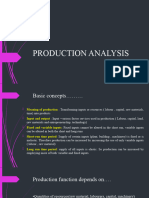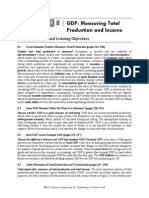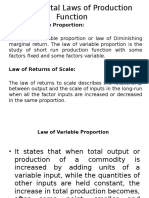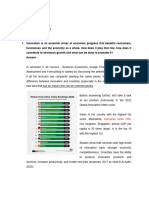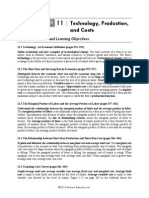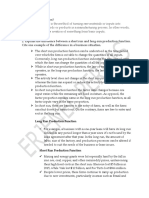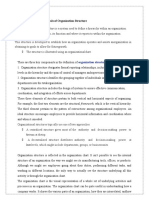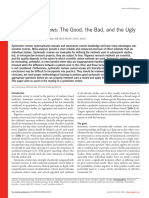0 ratings0% found this document useful (0 votes)
35 viewsMain Characteristics of A GPT: It and Productivity
Main Characteristics of A GPT: It and Productivity
Uploaded by
Izza WrapA General Purpose Technology (GPT) has wide application across multiple industries and has a strong impact on productivity. It must have potential for improvement, broad applicability, use in many products/processes, and complementarities with other technologies. Productivity measures output per input and increases when the same output is produced with fewer inputs, such as when new inventions allow more cars to be produced in the same time period. Higher productivity leads to higher incomes, lower costs of production, and lower prices, benefiting consumers.
Copyright:
© All Rights Reserved
Available Formats
Download as DOCX, PDF, TXT or read online from Scribd
Main Characteristics of A GPT: It and Productivity
Main Characteristics of A GPT: It and Productivity
Uploaded by
Izza Wrap0 ratings0% found this document useful (0 votes)
35 views3 pagesA General Purpose Technology (GPT) has wide application across multiple industries and has a strong impact on productivity. It must have potential for improvement, broad applicability, use in many products/processes, and complementarities with other technologies. Productivity measures output per input and increases when the same output is produced with fewer inputs, such as when new inventions allow more cars to be produced in the same time period. Higher productivity leads to higher incomes, lower costs of production, and lower prices, benefiting consumers.
Original Title
IT 2
Copyright
© © All Rights Reserved
Available Formats
DOCX, PDF, TXT or read online from Scribd
Share this document
Did you find this document useful?
Is this content inappropriate?
A General Purpose Technology (GPT) has wide application across multiple industries and has a strong impact on productivity. It must have potential for improvement, broad applicability, use in many products/processes, and complementarities with other technologies. Productivity measures output per input and increases when the same output is produced with fewer inputs, such as when new inventions allow more cars to be produced in the same time period. Higher productivity leads to higher incomes, lower costs of production, and lower prices, benefiting consumers.
Copyright:
© All Rights Reserved
Available Formats
Download as DOCX, PDF, TXT or read online from Scribd
Download as docx, pdf, or txt
0 ratings0% found this document useful (0 votes)
35 views3 pagesMain Characteristics of A GPT: It and Productivity
Main Characteristics of A GPT: It and Productivity
Uploaded by
Izza WrapA General Purpose Technology (GPT) has wide application across multiple industries and has a strong impact on productivity. It must have potential for improvement, broad applicability, use in many products/processes, and complementarities with other technologies. Productivity measures output per input and increases when the same output is produced with fewer inputs, such as when new inventions allow more cars to be produced in the same time period. Higher productivity leads to higher incomes, lower costs of production, and lower prices, benefiting consumers.
Copyright:
© All Rights Reserved
Available Formats
Download as DOCX, PDF, TXT or read online from Scribd
Download as docx, pdf, or txt
You are on page 1of 3
IT and PRODUCTIVITY
Economists interested in the pervasive effects of technological change in different
industrial revolutions have devised the concept of a General Purpose Technology
(GPT). It is a
technology of wide application used in various industries and whose impact is strong
on their
functioning.
Main Characteristics of a GPT
As you read the list, consider how a new technology such as electricity or information
technology fulfils each criterion.
●
It must have a wide scope for improvement and elaboration - this means that the
technology does not appear as a complete and final solution, but as a technology
that can
be improved through the different opportunities for technological change that
surround it.
●
It must be applicable across a broad range of uses - this means that its use is not
restricted, for example, to only one industry but open to many different types of
industries
and consumers.
●
It must have a potential use in a wide variety of products and processes - this means
that
the new technology should not result in the creation of only one set of products (such
as
a computer), but a wide set of products (such as complex new air-traffic control
systems
or new inventory controls).
●
It must have strong complementarities with existing or potential new technologies -
this
means that the technology does not only replace existing methods but also works
with
them, ensuring an even broader impact on the systems of production and
distribution.
Productivity
Productivity is the quality of producing something. It is a measure of the efficiency of
a person,
machine, factory, system, etc., in converting inputs into useful outputs. It is an
indication of the
efficiency of production or distribution. 8
Property of and for the exclusive use of SLU. Reproduction, storing in a retrieval system, distributing, uploading or posting online, or
transmitting in any form or by any
means, electronic, mechanical, photocopying, recording, or otherwise of any part of this document, without the prior written
permission of SLU, is strictly prohibited.
The Effect of Technology on Productivity
Labor productivity can be measured as output produced per hour of labor. For
example, consider
an automobile factory that is able to produce 10 cars per day using 100 hours of
labour. If a new
invention permits those same workers to produce 20 cars in the same amount of
time, their
productivity has been doubled.
Gross Domestic Product (GDP) - Total monetary or market value of all the finished
goods and
services produced within a country's borders in a specific time period. Total output
divided by total
labour hours in the year gives us a measure of labour productivity. A 5 per cent
growth in UK
productivity over a year means that the UK economy has become 5 percent more
productive than
it was in the previous year. This should mean that the economy can produce 5 per
cent more
output (GDP) with the same amount of inputs.
Example Computation for Productivity
Question1: If a group of workers produces 10,000 units of output in one year, and
12,000 units
the next year. Calculate the percentage increase in productivity.
Answer:
You want to know the percentage increase represented by the second year's output,
12,000,
over the first year's output, 10,000. Subtracting 10,000 from 12,000 gives us the
increase.
Divide the answer by 10,000 to calculate the increase relative to the first year. Then
multiply by
100 to turn the answer into a percentage.
12,000 − 10,000 = 2,000 ;
2,000
10
,000 ∗100 = 20%
So, output increased by 20 percent. As the number of workers stayed the same, this
is also the
increase in productivity.
Question2: Calculate the percentage increase in productivity if the output expands
from 12,000
in year 2 to 15,000 in year 3.
Answer:
Division of Labor and Productivity
The division of labor refers to the degree to which the various tasks involved in the
production of a good or service are divided among different workers.
Productivity increases when the division of labor increases. Increases in productivity
can
be transmitted throughout the economy for several reasons:
● Productivity – Income
Increases in productivity can lead to higher incomes for an economy's citizens. All
output
must be transformed, through the process of production and sale, into someone's
income (e.g.
the boss's profits and the workers’ wages). Hence, increases in productivity, which
allow more
output to be produced by a given amount of inputs, also lead to more income per
head, that is,
greater wealth for society. For example, if more cars can be produced due to
increases in the
productivity of car production, more cars are sold, which means that the car
manufacturers’
revenues increase.
● Productivity – Cost of Production9
Property of and for the exclusive use of SLU. Reproduction, storing in a retrieval system, distributing, uploading or posting online, or
transmitting in any form or by any
means, electronic, mechanical, photocopying, recording, or otherwise of any part of this document, without the prior written
permission of SLU, is strictly prohibited.
If increases in wages are linked to increases in productivity, then workers’ wages
may also
rise (or, at least, their employment prospects may be more secure). Second,
increases in
productivity diffused throughout the economy have an effect on prices. Increases in
productivity
tend to lower the cost of production, precisely because more output can be produced
with the
same amount of inputs. Since cost reductions tend to be translated into price
reductions,
increases in productivity eventually tend to reduce prices. Indeed, the introduction of
assembly
lines made a substantial contribution to the affordability of consumer durables such
as the car.
The increase in income per head and the reduction in prices allow consumers to be
better off.
Prices and Industrial Change
How can we look at price changes over time in industries in which the product
undergoes
many changes, especially in early stages? We use the concept of the price index.
Indices are
used a lot in economics. They are basically a simple way of measuring change.
Price index is a measure of the average level of prices for some specified set of
goods
and services, relative to the prices of a specified base period. The most widely used
method of
constructing an index is based on the notion of the percentage. An example is
provided below.
Suppose that the price of a product is Php 500 in 2000 and Php 750 in 2001 and Php
1000 in 2002. In this simple example, our market basket consists of only one product.
Selecting
year 2000 as the base year, we can express the prices in years 2001 and 2002
relative to the
price in year 2000 as follows:
The price in year 2000 (base year) is equal to 100 percent
750
500) ∗ 100 = 150,
1000
500 ) ∗ 100 = 200
Changes in Industry Structure
Industry structure refers mainly to the way in which power is distributed among firms.
This
can be described by factors such as the number of firms in the industry and the
distribution of
market shares.
You might also like
- Unit 5 - Information Technology and Emerging TrendsDocument15 pagesUnit 5 - Information Technology and Emerging Trendslucky dolphinNo ratings yet
- UntitledDocument16 pagesUntitledclarisseNo ratings yet
- Labour ProductivityDocument2 pagesLabour Productivityabdul WahabNo ratings yet
- Economics Chapter 6 SummaryDocument7 pagesEconomics Chapter 6 SummaryAlex HdzNo ratings yet
- GITDocument14 pagesGITKathleen RosarioNo ratings yet
- Production and CostsDocument45 pagesProduction and Coststanishkaverekar.1506No ratings yet
- Module 2 Productivity and ProfitabilityDocument10 pagesModule 2 Productivity and ProfitabilityAngel HermosisimaNo ratings yet
- Sebi Grade A 2020: Economics-Multiplier & AcceleratorDocument6 pagesSebi Grade A 2020: Economics-Multiplier & AcceleratorThabarak ShaikhNo ratings yet
- Mba HRD Ii Sem 202Document11 pagesMba HRD Ii Sem 202Grace Joy MarcelinoNo ratings yet
- Git Lecture NotesDocument13 pagesGit Lecture NotesKim CacapNo ratings yet
- Q. What Do You Mean by Productivity? What Are The Various Factors Affecting It?Document27 pagesQ. What Do You Mean by Productivity? What Are The Various Factors Affecting It?Prabhat MalikNo ratings yet
- OBL GIT Class Notes 2020Document100 pagesOBL GIT Class Notes 2020VJSNo ratings yet
- Unit 7Document22 pagesUnit 7Sandhya ChimmiliNo ratings yet
- Production and Productivity: Lecture Session 01Document23 pagesProduction and Productivity: Lecture Session 01Charitha RanwalaNo ratings yet
- Lesson 4Document2 pagesLesson 4Maurice AgbayaniNo ratings yet
- WEEK3 LESSON 4 Production FunctionDocument4 pagesWEEK3 LESSON 4 Production FunctionSixd Waznine100% (1)
- Productivity ModelsDocument8 pagesProductivity ModelsSuhas FundeNo ratings yet
- Labor ProductivityDocument7 pagesLabor ProductivityIoanna ZlatevaNo ratings yet
- Financial DictionaryDocument15 pagesFinancial DictionaryMJoyce Dela CruzNo ratings yet
- Unit 2 CC 4Document28 pagesUnit 2 CC 4Kamlesh AgrawalNo ratings yet
- Chapter 7Document16 pagesChapter 7ayandasmtsNo ratings yet
- Econ201 - Lecture Notes - Production and CostDocument5 pagesEcon201 - Lecture Notes - Production and CostDoreen Platon EstalarNo ratings yet
- 3 & 4 - National Income AccountingDocument27 pages3 & 4 - National Income AccountingAshish SinghNo ratings yet
- LABOUR PRODCUTIVITY CONTROL - Roll No01Document4 pagesLABOUR PRODCUTIVITY CONTROL - Roll No01architect.veeruNo ratings yet
- ECON Macroeconomics 4 4th Edition McEachern Solutions Manual DownloadDocument9 pagesECON Macroeconomics 4 4th Edition McEachern Solutions Manual DownloadJeremy Leng100% (23)
- Micro and Macro Economics PDFDocument29 pagesMicro and Macro Economics PDFMayank JainNo ratings yet
- Production and Business Organization: Chapter SixDocument14 pagesProduction and Business Organization: Chapter Sixdipon sakibNo ratings yet
- ECON 1100 Mid-Term Cp. 8-13 NotesDocument39 pagesECON 1100 Mid-Term Cp. 8-13 NoteslaylaNo ratings yet
- The Division of LabourDocument11 pagesThe Division of LabourMaria StancanNo ratings yet
- GIT: Living in The IT EraDocument25 pagesGIT: Living in The IT EraSana MinatozakiNo ratings yet
- Chap 024Document14 pagesChap 024KhayHninsNo ratings yet
- External Economies of Scale and The Internal Location of ProductionDocument10 pagesExternal Economies of Scale and The Internal Location of ProductionCarolina MinghettiNo ratings yet
- Production AnalysisDocument42 pagesProduction Analysisitabid04No ratings yet
- GDP: Measuring Total Production and Income: Chapter Summary and Learning ObjectivesDocument22 pagesGDP: Measuring Total Production and Income: Chapter Summary and Learning Objectivesvivianguo23No ratings yet
- Laws of Production FunctionDocument32 pagesLaws of Production Functionchandanpalai91No ratings yet
- Increasing Returns To Scale in ProductionDocument8 pagesIncreasing Returns To Scale in ProductionjulieNo ratings yet
- Midterm Basic Microeconomics Week 1 6 2Document114 pagesMidterm Basic Microeconomics Week 1 6 2Franchescka Rhomae MontesNo ratings yet
- Edexcel Economics (A) A-Level Theme 4: A Global PerspectiveDocument33 pagesEdexcel Economics (A) A-Level Theme 4: A Global Perspectiveggg182048No ratings yet
- İzmir Institute of Technology Faculty of Engineering DepartmentDocument11 pagesİzmir Institute of Technology Faculty of Engineering DepartmentMehmet KırgözoğluNo ratings yet
- AS Micro Notes - NIDocument54 pagesAS Micro Notes - NIabdullahkhanazeemNo ratings yet
- 3.1 Production Analysis and Concept of MarginalityDocument4 pages3.1 Production Analysis and Concept of MarginalityFoisal Mahmud RownakNo ratings yet
- Micro EconomicsDocument10 pagesMicro EconomicsAnkur SinhaNo ratings yet
- UAS Business EconomicsDocument9 pagesUAS Business EconomicsAslin Ovita DamayantiNo ratings yet
- Cost Analysis - Fast Moving Consumer Durables Industry: NOVEMBER 2, 2018Document8 pagesCost Analysis - Fast Moving Consumer Durables Industry: NOVEMBER 2, 2018Saurabh SinghNo ratings yet
- Unit III Theory of Production and CostDocument15 pagesUnit III Theory of Production and CostAarti HaswaniNo ratings yet
- Technology, Production, and Costs: Chapter Summary and Learning ObjectivesDocument34 pagesTechnology, Production, and Costs: Chapter Summary and Learning ObjectivesRoxana CabreraNo ratings yet
- Lecture 4 For ClassDocument18 pagesLecture 4 For ClasswafulaspencerNo ratings yet
- Relevance of Production Function and Economic Scale in Developing Economics - 21BSP2428 - Anusha - MeneDocument12 pagesRelevance of Production Function and Economic Scale in Developing Economics - 21BSP2428 - Anusha - MeneShivam SinghNo ratings yet
- Labour Productivity and Unit Labour Costs Indicator (KILM 18)Document15 pagesLabour Productivity and Unit Labour Costs Indicator (KILM 18)rasub987No ratings yet
- Microeconomics Cha 3Document13 pagesMicroeconomics Cha 3haile GetachewuNo ratings yet
- ECNM023 SPR2324 Week 5Document39 pagesECNM023 SPR2324 Week 5Zia Ul Hassan KhanNo ratings yet
- ProductivityDocument6 pagesProductivityMallikarjun ReddyNo ratings yet
- Unit IDocument10 pagesUnit Ithanigaivelu4No ratings yet
- Marif SchoolDocument10 pagesMarif Schooltajumama720No ratings yet
- EEE 410: Technology ManagementDocument30 pagesEEE 410: Technology ManagementAsnad AhmedNo ratings yet
- Production and Cost TheoryDocument79 pagesProduction and Cost TheoryMaria Datingaling100% (1)
- Activity 6 - Theory of Production and CostDocument5 pagesActivity 6 - Theory of Production and CostJelo DavidNo ratings yet
- Production Part 2Document12 pagesProduction Part 2nrv2hcm25cNo ratings yet
- Production and Business Organization PDFDocument12 pagesProduction and Business Organization PDFUmerSaeedNo ratings yet
- Unit 4: Systems Development Life Cycle - Planning: Lecture ObjectivesDocument2 pagesUnit 4: Systems Development Life Cycle - Planning: Lecture ObjectivesIzza WrapNo ratings yet
- Art 5: Unit 5 (15 PTS) Part 6: Unit 8 (10 PTS) GRADED Activity: Midterm ExaminationDocument3 pagesArt 5: Unit 5 (15 PTS) Part 6: Unit 8 (10 PTS) GRADED Activity: Midterm ExaminationIzza WrapNo ratings yet
- With The Different Technological Advancements, Businesses Have Adopted Newer Processes and HaveDocument3 pagesWith The Different Technological Advancements, Businesses Have Adopted Newer Processes and HaveIzza WrapNo ratings yet
- GRADED Activity 2 Part 1: Unit 3 (10 PTS) : Lesson 04 Video 01 Payback PeriodDocument2 pagesGRADED Activity 2 Part 1: Unit 3 (10 PTS) : Lesson 04 Video 01 Payback PeriodIzza WrapNo ratings yet
- Additional Example: - Saving Money Is: Roi or Payback Period? (Newleaf, 2012)Document4 pagesAdditional Example: - Saving Money Is: Roi or Payback Period? (Newleaf, 2012)Izza WrapNo ratings yet
- DFD Naming ConventionDocument3 pagesDFD Naming ConventionIzza WrapNo ratings yet
- Guidelines That Will Help You Design Data Entry ScreensDocument4 pagesGuidelines That Will Help You Design Data Entry ScreensIzza WrapNo ratings yet
- It 9Document3 pagesIt 9Izza WrapNo ratings yet
- Work-in-the-Digital-Age-1.pdf: He Platform Economy See Pages 163-174Document4 pagesWork-in-the-Digital-Age-1.pdf: He Platform Economy See Pages 163-174Izza WrapNo ratings yet
- It 14Document3 pagesIt 14Izza WrapNo ratings yet
- A. Project Initiation (Project Identification)Document4 pagesA. Project Initiation (Project Identification)Izza WrapNo ratings yet
- Fme 3Document1 pageFme 3Izza WrapNo ratings yet
- Merchandising Organized As A Partnership BusinessDocument23 pagesMerchandising Organized As A Partnership BusinessIzza WrapNo ratings yet
- Literary Criticism: A. JudgementDocument3 pagesLiterary Criticism: A. JudgementIzza WrapNo ratings yet
- Step 2: Estimate Risk and Potential Losses. Once You Identify Your Exposures To RiskDocument2 pagesStep 2: Estimate Risk and Potential Losses. Once You Identify Your Exposures To RiskIzza WrapNo ratings yet
- Major Monotheistic Religions in The World: ChristiniatyDocument5 pagesMajor Monotheistic Religions in The World: ChristiniatyIzza Wrap100% (1)
- Kirk Simonovski ResumeDocument2 pagesKirk Simonovski Resumeapi-314639431No ratings yet
- SA Spanish CompanyDocument6 pagesSA Spanish CompanysmentorNo ratings yet
- VLSI Design Automation of A Montgomery Multiplier Using Astro by ...Document24 pagesVLSI Design Automation of A Montgomery Multiplier Using Astro by ...Ramya ScNo ratings yet
- CHAPTER 3 Organization TheoryDocument10 pagesCHAPTER 3 Organization TheorykebedeNo ratings yet
- Me 2254 ModelDocument2 pagesMe 2254 Modeldevarajs2010No ratings yet
- Product Brief Western Digital WD Red Plus HDDDocument3 pagesProduct Brief Western Digital WD Red Plus HDDBogdan PrascevicNo ratings yet
- CS252 Slides NewDocument642 pagesCS252 Slides NewAlice YewNo ratings yet
- Global Business EnvironmentDocument77 pagesGlobal Business EnvironmentNiña Mae DiazNo ratings yet
- Oracle Application Express (APEX) 5.0 Installation: SetupDocument23 pagesOracle Application Express (APEX) 5.0 Installation: Setupa3scribdNo ratings yet
- Nelson Morales Guilty of Second Degree Murder of NYPD Police OfficerDocument1 pageNelson Morales Guilty of Second Degree Murder of NYPD Police OfficerbukhlawfirmNo ratings yet
- MSDS Epikure 548Document13 pagesMSDS Epikure 548trường phạmNo ratings yet
- A MatlabSimulink Model For Capacitor Voltages Balancing inDocument6 pagesA MatlabSimulink Model For Capacitor Voltages Balancing inSudip MondalNo ratings yet
- Retention ScaleDocument4 pagesRetention ScalejofiyaNo ratings yet
- Mastercard PresentationDocument32 pagesMastercard PresentationZhaxylyk SayaNo ratings yet
- TRIETHYLENE GLYCOL - CAMEO Chemicals - NOAADocument4 pagesTRIETHYLENE GLYCOL - CAMEO Chemicals - NOAAhorstiillingNo ratings yet
- The Discerning Trader LBRDocument8 pagesThe Discerning Trader LBRSteven Watson100% (2)
- AMT 115 Midterm Module 2Document7 pagesAMT 115 Midterm Module 2Earl Michaelo R. KalacasNo ratings yet
- Custom Bid CatalogueDocument22 pagesCustom Bid CatalogueJojy SebastianNo ratings yet
- Borang KPKK11 Version EnglishDocument3 pagesBorang KPKK11 Version EnglishTan Choong Shen100% (1)
- Impact of Macroeconomic Policies To The Unemployment Situation in The PhilippinesDocument7 pagesImpact of Macroeconomic Policies To The Unemployment Situation in The Philippineskenah suzzane angNo ratings yet
- English IIIDocument5 pagesEnglish IIILaura Bran RuedaNo ratings yet
- Aum Prev LogDocument46 pagesAum Prev LogYoutube PremiumNo ratings yet
- ZTE Carrier Aggregation SolutionDocument5 pagesZTE Carrier Aggregation Solutionhasan doganNo ratings yet
- Forms and Functions of State and Non-StateDocument37 pagesForms and Functions of State and Non-Stateapril rancesNo ratings yet
- CRUZ v. CABAÑADocument2 pagesCRUZ v. CABAÑAKaren Ryl Lozada BritoNo ratings yet
- Manual Book Daihatsu Hijet 1000: 11.pdf 152 PDFDocument16 pagesManual Book Daihatsu Hijet 1000: 11.pdf 152 PDFAnton Seroja SaniNo ratings yet
- What To Say in Thesis DefenseDocument8 pagesWhat To Say in Thesis Defenseafkogftet100% (1)
- Systematic Reviews The Good, The Bad, and The Ugly - Yuan and Hunt (2009)Document7 pagesSystematic Reviews The Good, The Bad, and The Ugly - Yuan and Hunt (2009)felipeNo ratings yet
- AD250 Wireless Datasheet WebDocument12 pagesAD250 Wireless Datasheet WebArumugam RajendranNo ratings yet
- 114.E-SHOT Issue 114 - September 2020Document52 pages114.E-SHOT Issue 114 - September 2020olimpio.braga.salesmanagerNo ratings yet















